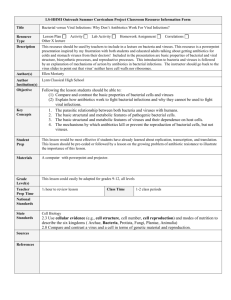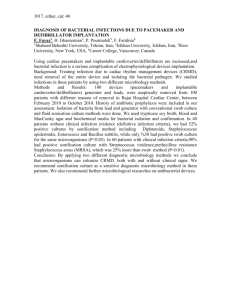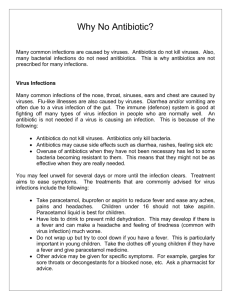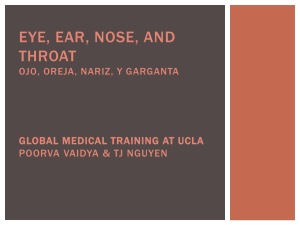2261outline
advertisement
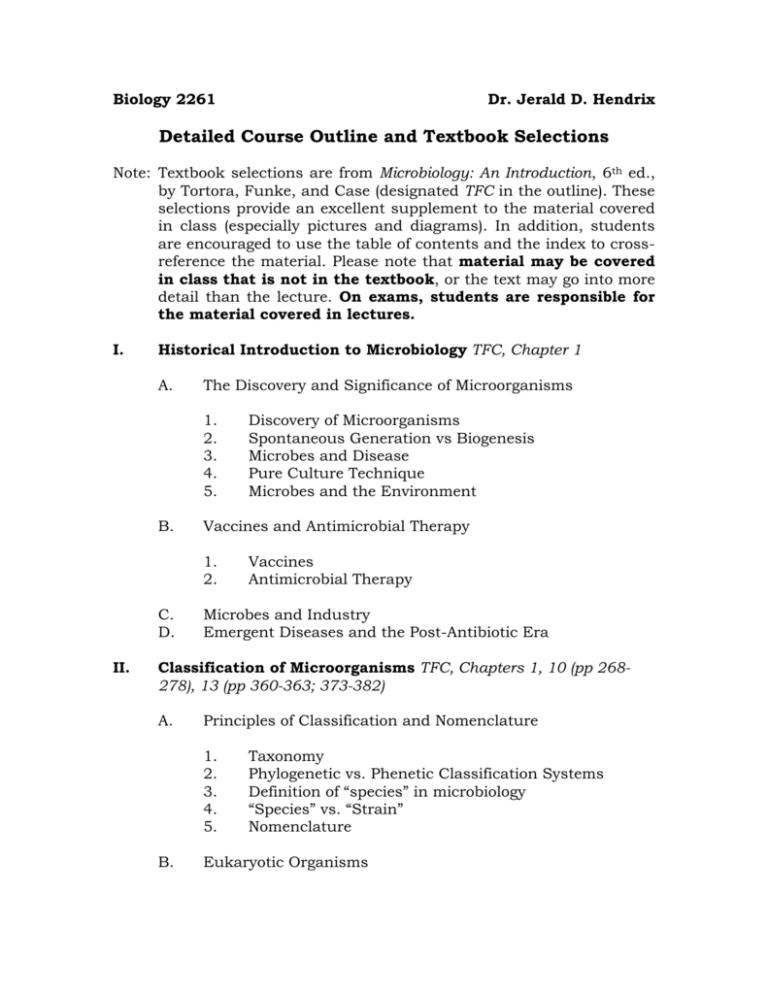
Biology 2261 Dr. Jerald D. Hendrix Detailed Course Outline and Textbook Selections Note: Textbook selections are from Microbiology: An Introduction, 6th ed., by Tortora, Funke, and Case (designated TFC in the outline). These selections provide an excellent supplement to the material covered in class (especially pictures and diagrams). In addition, students are encouraged to use the table of contents and the index to crossreference the material. Please note that material may be covered in class that is not in the textbook, or the text may go into more detail than the lecture. On exams, students are responsible for the material covered in lectures. I. Historical Introduction to Microbiology TFC, Chapter 1 A. The Discovery and Significance of Microorganisms 1. 2. 3. 4. 5. B. Vaccines and Antimicrobial Therapy 1. 2. C. D. II. Discovery of Microorganisms Spontaneous Generation vs Biogenesis Microbes and Disease Pure Culture Technique Microbes and the Environment Vaccines Antimicrobial Therapy Microbes and Industry Emergent Diseases and the Post-Antibiotic Era Classification of Microorganisms TFC, Chapters 1, 10 (pp 268278), 13 (pp 360-363; 373-382) A. Principles of Classification and Nomenclature 1. 2. 3. 4. 5. B. Taxonomy Phylogenetic vs. Phenetic Classification Systems Definition of “species” in microbiology “Species” vs. “Strain” Nomenclature Eukaryotic Organisms 1. 2. C. Prokaryotic Organisms 1. 2. D. Prokaryotic Cells Prokaryotic Kingdoms Viruses 1. 2. III. Eukaryotic Cells Eukaryotic Kingdoms Structure of a “Virus Particle” Viral Replication Infection and Disease TFC, Chapters 14 & 15 A. Definitions 1. 2. 3. 4. 5. 6. 7. 8. 9. 10. 11. 12. 13. 14. 15. B. The Normal Flora of Humans 1. 2. 3. 4. C. Disease and Infectious Disease Pathogenicity and Virulence Acute Infection vs Chronic Infection Primary Infection vs Secondary Infection Localized Infection vs Systemic Infection Clinical Infection vs Subclinical Infection Opportunistic Infection The suffix “-emia” The suffix “-itis” Epidemiology Communicable, contagious, and noncommunicable Endemic, epidemic, and pandemic Reservoir of infection, carrier, fomites, and animal vectors Direct Mechanisms of Disease Transmission Indirect Mechanisms of Disease Transmission Types of Symbiosis Location of the Normal Flora Benefits of the Normal Flora Normal Flora and Opportunistic Infections Generalized Stages of Infection 1. 2. 3. 4. Entry of Pathogen Colonization Incubation period Prodromal Symptoms 5. 6. 7. D. Virulence Factors and Toxins 1. 2. 3. 4. 5. 6. IV. State of the Host Immune System Number of Pathogenic Cells Enzymatic Virulence Factors Adhesion Factors Exotoxins Endotoxins Bacterial Structure and Growth TFC, Chapter 4, pp 76-98; Chapter 6, pp 154-162 A. Bacterial Cells: An Overview 1. 2. B. C. Shapes and Arrangements Sizes Bacterial Cell Structures 1. 2. 3. 4. 5. 6. 7. 8. 9. Capsules Cell Wall Plasma Membrane Cytoplasm & Cytoplasmic Inclusions Ribosomes Bacterial DNA Pili Flagella Spores Factors that Influence Bacterial Growth 1. 2. 3. 4. 5. V. Invasive period Decline of infection Convalescence Growth vs Survival Nutrient Requirements Temperature pH Oxygen Bacterial Diseases TFC Chapters 11 and 21-26 (“Bacterial Diseases” sections; pages corresponding to specific topics are listed below) A. Airborne Bacterial Diseases 1. 2. 3. 4. 5. 6. 7. 8. 9. B. Foodborne & Waterborne Bacterial Diseases 1. 2. 3. 4. 5. 6. 7. 8. 9. 10. C. Anthrax (pp 607-608) Tetanus (pp 584-585) Gas Gangrene (pp 608-609) Leptospirosis (pp 695-696) Listeriosis (p 584) Arthropodborne Bacterial Diseases 1. 2. 3. 4. 5. E. Foodborne Intoxications vs Infections Botulism (pp 585-586) Staphylococcal Food Poisoning (pp 663-664) Clostridial Food Poisoning (p 671) Typhoid Fever (pp 666-668) Salmonellosis (pp 664-666) Shigellosis (p 664) Cholera (pp 668-669) Diseases associated with Escherichia coli (pp 669-670) Camphylobacteriosis and Helicobacteriosis (p 670) Soilborne Bacterial Diseases 1. 2. 3. 4. 5. D. Streptococcal Diseases (pp 632-634; 604-606; 511; 563-564) Diphtheria (pp 634-635) Pertussis (pp 636-637) Meningococcal Infections (pp 582-583) Haemophilus influenzae Infections (pp 581-582; 642; 635) Tuberculosis (pp 637-641) Pneumococcal Pneumonia (pp 642; 583; 635) Primary Atypical Pneumonia (p 643) Legionellosis (pp 643-644) Plague (pp 609-611) Lyme Disease (pp 611-613) Rocky Mt. Spotted Fever (pp 614-615) Epidemic Typhus (p 613) Endemic Typhus (p 613) Sexually Transmitted Bacterial Diseases 1. 2. 3. Syphilis (pp 701-704) Gonorrhea (pp 697-700) Chlamydia (pp 700-701) 4. F. Miscellaneous Bacterial Diseases 1. 2. 3. VI. Chanchroid (p 704) Leprosy (pp 587-588) Staphylococcal Infections (pp 562-563) Pseudomonas aeruginosa Infections (pp 564-565) Viral Diseases TFC Chapters 13 (pp 360-363; 373-382) and 21-26 (“Viral Diseases” sections; pages corresponding to specific topics are listed below) A. Influenza (pp 646-648; 568) 1. 2. B. Diseases Caused by the Herpes Family 1. 2. 3. 4. 5. C. Hepatitis A Hepatitis B Non-A, Non-B Hepatitis Human Immunodeficiency Virus (pp 519-527) 1. 2. 3. 4. 5. E. Properties of the Herpes Virus Family Herpes Simplex (pp 569-570) Chicken pox & Shingles (pp 567-569) Infectious Mononucleosis (pp 615-616) Cytomegalovirus (pp 672-673) Viral Hepatitis (pp 673-677) 1. 2. 3. D. Properties Symptoms and Complications of Influenza Viral Properties Transmission HIV & AIDS CDC Case Surveillance Definition for AIDS Symptoms & Secondary Infections Associated with AIDS Miscellaneous Viral Diseases 1. 2. 3. 4. Miscellaneous Miscellaneous Miscellaneous Miscellaneous Pneumotrophic Viruses (pp 635-636; p 645) Dermotrophic Viruses (pp 570-572; p 570) Viscerotrophic Viruses (p 677) Neurotrophic Viruses (pp 588-593) 5. VII. Prion Diseases (pp 596-597) Fungal Diseases TFC Chapters 12 (pp 320-330) and 21-26 (“Fungal Diseases” sections; pages corresponding to specific topics are listed below) A. B. C. D. Basic Properties of the Fungi Candidiasis (p 573; 707) Dermatomycoses (pp 572-573) Respiratory Fungal Infections (pp 648-651) VIII. Protozoan Diseases TFC Chapters 12 (pp 339-344) and 21-26 (“Protozoan Diseases” sections; pages corresponding to specific topics are listed below) A. B. C. D. E. F. G. H. I. J. IX. Basic Properties of Protozoa Amebiasis (pp 678-679) Primary Amebic Meningoencephalitis (pp 595-596) Giardiasis (p 678) Trichomoniasis (pp 707-708) Balantidiasis (no pages) Toxoplasmosis (pp 618-619) Malaria (pp 619-621) Cryptosporidiosis (p 679) Pneumocystosis (pp 649-651) Selected Diseases caused by Multicellular Animal Parasites TFC Chapters 12 (pp 344-350) and 21-26 (“Helminthic Diseases” sections; pages corresponding to specific topics are listed below) A. Diseases caused by Flatworms 1. 2. B. Schistosomiasis (pp 622-624) Tapeworms (pp 680-681) Diseases caused by Roundworms (pp 681-683) 1. 2. 3. Ascariasis Pinworms Trichinosis
